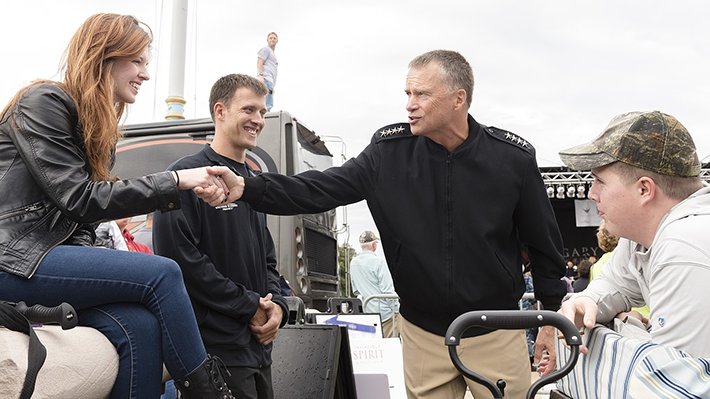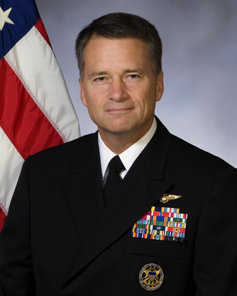Retired Navy Admiral Is Working to Prevent Drug Overdoses

The media is so often filled with unhappy circumstances, lousy news, hardships, and unpleasant events. That’s what sells. So when USA Today featured an interview with a retired U.S. Navy admiral about a non-profit that he and his wife started to counter the opioid epidemic, I was pleased to see a break in the morose news updates I had become so used to.
The admiral and his wife had lost a son to a drug overdose. But rather than succumbing to grief and misery as most parents would (and understandably so), the Winnefelds started a non-profit campaign. Their campaign took off and has helped hundreds of families connect their addicted loved ones to safe and effective treatment programs. The efforts of the Winnefelds are something for us all to be encouraged by, because their efforts are precisely the types of initiatives that we need to see more of.
Our drug problem has long since passed the point of being a health problem that the government can eliminate or even effectively reduce. It’s going to take community action, mutual support, group effort, and a lot of commitment and time to overcome this problem.
So how are the Winnefeld’s doing their part, and what might we learn from the example they have set?
Admiral Winnefeld and the SAFE Project

In November of 2017, retired U.S. Navy Admiral James Winnefeld and his wife, Mary Winnefeld, lost their 19-year old son Jonathan to an accidental opioid overdose. Jonathan was on his fourth day of his first, freshman semester in college.
To channel their grief and anguish into action, the Winnefelds immediately launched a non-profit effort called SAFE Project. SAFE Project is a multi-faceted campaign aimed to help other families who have sons and daughters who are currently struggling or who have struggled with addiction in the past.
Quoting Admiral Winnefeld in his interview with USA Today about the six branches of SAFE Project: “We have essentially six lines of operation. It’s about public awareness to gain support for reversing the epidemic and lowering stigma. It’s about prevention, which is basically getting to the most vulnerable of audiences with the most credible voices. It’s about getting our arms around prescription medicines. It’s about law enforcement and medical response in that we are not going to arrest our way out of this. And then treatment and recovery. There simply aren’t enough treatment resources or availability of recovery services. And last but not least, is family outreach and support.”
SAFE Project is beneficial because it creates a multifaceted strategy in combating the drug problem. That approach is absolutely spot on, as the drug problem itself is a multifaceted crisis that requires a skilled and versatile approach in remedying it.
Admiral Winnefeld also advised families on how to help get their sons and daughters into addiction treatment. Admiral Winnefeld counseled families on two routes of action for merely getting their family members to be willing to seek treatment:
- The first route comes about because of an ongoing and increasing presence of addiction and drug use within a loved one’s life. As the loved one’s habit gets worse and the drug problem grows, the family begins to plan for an intervention. Admiral Winnefeld encourages families to perform interventions on their loved ones, to prepare for those interventions, to seek the help of professional interventionists, and to perform follow-up interventions if necessary.
- Admiral Winnefeld went on to talk about using moments of crisis as incentives to get a loved one into treatment. If intervention is not working and no amount of convincing and encouraging is effective in getting a loved one to seek help, the admiral suggests that families use times of hardship, such as a survived overdose, a car accident, losing a job, a divorce, or any of the other many difficulties that addicts face, as a means of convincing the addict that he must get help.
Last but not least, Admiral Winnefeld talked about the struggle for finding useful and reliable drug and alcohol addiction treatment. He spoke on how families are often in disarray, frantically seeking a treatment center for their loved one before it’s too late. Again, the severe lack of availability in residential drug treatment is a huge problem in getting loved ones into a safe and effective recovery program and in doing so quickly. One of the goals of the SAFE Project is to make treatment more available and to help families find treatment rapidly.
Seeking Help for a Loved One

Programs like the SAFE Project are doing great things in addressing the addiction epidemic. In a lot of ways, the SAFE Project is one of the better non-profits out there, because it correctly labels and addresses six, critical aspects of the drug crisis. Summarizing what the admiral said, effectively combating the drug problem involves:
- Raising public awareness for the epidemic and garnering support from the public.
- Promoting prevention efforts by getting the most vulnerable people in touch with key voices and correct data.
- Curbing the prescription drug epidemic by reigning in prescription drugs.
- Getting with law enforcement to ensure we don’t try to “arrest our way” out of the problem.
- Promoting treatment and recovery and creating more treatment centers to help addicts get clean.
- Providing help and support for the families affected by the addiction epidemic.
These approaches are all spot on. If our nation as a whole came together and worked on the above six strategies in tandem, our fatal drug-addiction crisis would recede rapidly.
And what should you do if you are personally affected by the epidemic? What should you do if you have a family member or loved one who is struggling with a drug problem? If you know someone who is addicted to drugs and alcohol, your priority becomes one of getting your loved one into a residential drug and alcohol addiction treatment center as soon as possible.
As we can see from examining the statistics published by SAFE Project and by hearing the admiral’s own personal story, drug and alcohol addiction is a fatal affliction. People cannot beat addiction on their own. And they cannot continue to use drugs and alcohol forever and expect to survive. If you know someone who is addicted, make sure they get into a residential treatment center as soon as possible. Such a program offers the only safe and practical approach to freeing people from the shackles of addiction.
Sources:
- https://www.safeproject.us/about-us/
- https://www.usatoday.com/videos/opinion/2019/08/19/opioid-addiction-took-his-son-now-navy-admiral-works-reduce-opioid-overdose-deaths-among-college-stu/1988954001/


 ®
®